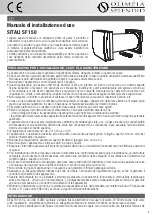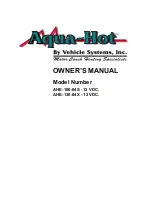
This Data Sheet may be revised by subsequent versions ©2004 Eon Silicon Solution, Inc., www.eonssi.com
or modifications due to changes in technical specifications.
7
EN25F16
Rev. F, Issue Date: 2009/03/16
OPERATING FEATURES
SPI Modes
The EN25F16 is accessed through an SPI compatible bus consisting of four signals: Serial Clock (CLK),
Chip Select (CS#), Serial Data Input (DI) and Serial Data Output (DO). Both SPI bus operation Modes 0
(0,0) and 3 (1,1) are supported. The primary difference between Mode 0 and Mode 3, as shown in
Figure 3, concerns the normal state of the CLK signal when the SPI bus master is in standby and data
is not being transferred to the Serial Flash. For Mode 0 the CLK signal is normally low. For Mode 3 the
CLK signal is normally high. In either case data input on the DI pin is sampled on the rising edge of the
CLK. Data output on the DO pin is clocked out on the falling edge of CLK.
Figure 3. SPI Modes
Page Programming
To program one data byte, two instructions are required: Write Enable (WREN), which is one byte, and
a Page Program (PP) sequence, which consists of four bytes plus data. This is followed by the internal
Program cycle (of duration t
PP
).
To spread this overhead, the Page Program (PP) instruction allows up to 256 bytes to be programmed
at a time (changing bits from 1 to 0), provided that they lie in consecutive addresses on the same page
of memory.
Sector Erase, Block Erase and Chip Erase
The Page Program (PP) instruction allows bits to be reset from 1 to 0. Before this can be applied, the
bytes of memory need to have been erased to all 1s (FFh). This can be achieved a sector at a time,
using the Sector Erase (SE) instruction, a block at a time using the Block Erase (BE) instruction or
throughout the entire memory, using the Chip Erase (CE) instruction. This starts an internal Erase cycle
(of duration t
SE
t
BE
or t
CE
). The Erase instruction must be preceded by a Write Enable (WREN)
instruction.
Polling During a Write, Program or Erase Cycle
A further improvement in the time to Write Status Register (WRSR), Program (PP) or Erase (SE, BE or
CE ) can be achieved by not waiting for the worst case delay (t
W
, t
PP
, t
SE
, t
BE
or t
CE
). The Write In
Progress (WIP) bit is provided in the Status Register so that the application program can monitor its
value, polling it to establish when the previous Write cycle, Program cycle or Erase cycle is complete.
Active Power, Stand-by Power and Deep Power-Down Modes
When Chip Select (CS#) is Low, the device is enabled, and in the Active Power mode. When Chip
Select (CS#) is High, the device is disabled, but could remain in the Active Power mode until all internal
cycles have completed (Program, Erase, Write Status Register). The device then goes into the Stand-
by Power mode. The device consumption drops to I
CC1
.
The Deep Power-down mode is entered when the specific instruction (the Enter Deep Power-down
Mode (DP) instruction) is executed. The device consumption drops further to I
CC2
. The device remains
in this mode until another specific instruction (the Release from Deep Power-down Mode and Read
Device ID (RDI) instruction) is executed.
Содержание H-HT5115-N
Страница 1: ...SERVICE DVD 5 1 HOME THEATRE SYSTEM SERVICE MANUAL DA918PA H HT5115 N ...
Страница 125: ...2 Reference Information 2 1 Component Descriptions 2 1 1 DVD SONY HM 313 Connector Pin Definition 5 PUH ...
Страница 131: ......
Страница 139: ......
Страница 140: ......
Страница 141: ......
Страница 143: ......
Страница 145: ......
Страница 146: ......
















































